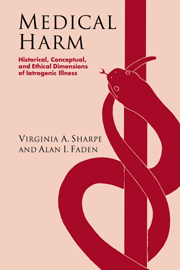Book contents
- Frontmatter
- Contents
- Acknowledgments
- Introduction
- Part I
- Part II
- Part III
- 7 From hospitalism to nosocomial infection control
- 8 Adverse effects of drug treatment
- 9 Unnecessary surgery
- 10 The concept of appropriateness in patient care
- 11 Recommendations for limiting iatrogenic harm
- Appendix
- Bibliography
- Index
10 - The concept of appropriateness in patient care
Published online by Cambridge University Press: 22 September 2009
- Frontmatter
- Contents
- Acknowledgments
- Introduction
- Part I
- Part II
- Part III
- 7 From hospitalism to nosocomial infection control
- 8 Adverse effects of drug treatment
- 9 Unnecessary surgery
- 10 The concept of appropriateness in patient care
- 11 Recommendations for limiting iatrogenic harm
- Appendix
- Bibliography
- Index
Summary
Appropriateness, values and risk
The shift to appropriateness in health services research underscores that judgments about surgical overuse and the provision of unnecessary services depend on prior judgments about the criteria for appropriate use. This shift is, in other words, an acknowledgment that clinically sound utilization decisions depend on a sound evidentiary basis regarding what works in clinical practice. Because only a small minority (15 to 20%) of treatments have been evaluated in rigorous scientific trials, however, this is a daunting task. It is also one that raises important and controversial questions about what counts as an authoritative form of evidence in determinations regarding efficacy, effectiveness, and safety – or in other words, regarding clinical benefit and harm. The shift to appropriateness also raises important questions regarding the values that do and should guide medical decision making. To say that something is ‘appropriate’ is to say that it is ‘suitable or fitting for a particular purpose, occasion, or person’. The term ‘appropriate’ is, thus, fundamentally evaluative; it implies the endorsement of some goal. ‘Appropriate for what and whom?’ and ‘appropriate to what and whose ends?’ are questions that must be answered, therefore, if the term is to be made meaningful.
Traditionally, the authority for clinical decision-making has rested with the physician; the physician was believed to know what was best or appropriate for a patient and due deference was paid to medical judgment.
- Type
- Chapter
- Information
- Medical HarmHistorical, Conceptual and Ethical Dimensions of Iatrogenic Illness, pp. 213 - 229Publisher: Cambridge University PressPrint publication year: 1998



